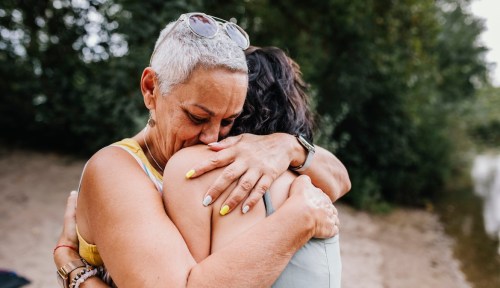Climate change is best understood as a shift in temperatures and weather patterns that results in long-term consequences for the Earth as well as the mental health of its inhabitants. Climate anxiety is sweeping the planet.
Experts in This Article
licensed clinical social worker and recovery specialist
Humans are living proof of climate anxiety in a period of uncertainty around the future of the planet and how we might continue our existence. “Direct impacts are already happening. For example, the prevalence in widespread wildfires, where the EPA indicates an increased wildfire season length, as well as in frequency and area burned,” says Kassondra Glenn, LMSW, a social worker and recovery specialist with Prosperity Haven.
Even those not yet directly exposed to harm from the climate crisis may feel the physical impacts, just by seeing data and using it to create scenarios in their minds to heighten stress levels and anxieties around it, and to dysregulate the nervous system. “Dysregulation can show up as muscle tension, digestive changes, racing thoughts, mood swings, fight/flight/freeze responses, and much more,” says Glenn.
And when this is experienced chronically, the fear and worry can be attributed to “climate anxiety,” which unfortunately can worsen and grow more cumbersome as the climate crisis worsens.
What Is Climate Anxiety?
“Climate change anxiety is an experience of overwhelm related to all that surrounds negative environmental shifts on our planet, with humans being a part of nature and thus closely tied to the environment,” says Glenn. Both data and the shifts we see and can sense tend to play a part in creating and prolonging anxiety around climate change and the future.
According to Glenn, climate anxiety symptoms include somatic signs, such as muscle tension, digestive changes and changes in sleeping patterns, psychological signs, such as racing thoughts, rumination and difficulty focusing, and lastly, relational signs, such as shifts in choices around having or not having children due to the state and prospective state of the planet.
And while some anxieties may lead to extreme or irrational thoughts, the root of the cause and issue in relation to climate anxiety, how to help climate change and its effects on the planet and our lifestyles, is pretty valid and rational in reasoning and thought.
And so, unless there’s more insight regarding what climate change is and how to help climate change from destroying the planet and impacting our future, climate change anxiety and mental distress can take effect and be hard to mitigate without such answers.
How To Manage Climate Anxiety
The best way to manage climate change anxiety is first by recognizing the anxiety and addressing it, as an issue, as well as being proactive in thinking of any ways to help climate change that might be practical.
You’re not wrong to have fears about it, and so that’s important to take note of before developing a field guide to climate anxiety and implementing practices to ease anxiety and feel more comfortable with feeling uncomfortable.
“Anxiety is an uncomfortable experience that can be tempting to push away, and we often think that ignoring anxiety will cause it to go away; however, what we ignore tends to grow larger,” says Glenn. So, by acknowledging climate change anxiety and its presence, it gives us an opportunity to identify underlying feelings and practice nervous system regulation to better manage symptoms and ease any fear or tension.
After acknowledging climate change anxiety for what it is and why it’s an issue, allow for grief to manifest and be experienced as part of the healing process. According to Glenn, one of the most common emotions underlying climate change anxiety is grief. “We are grieving our planet, the futures we thought we would have, and all that has already been lost to climate change,” says Glenn.
“If we only show up for anxiety itself, we are putting a band-aid on the root causes, so it’s important to let ourselves cry, to let ourselves be angry or scared, and yes, to let ourselves grieve,” Glenn says.
Embrace Support Groups or Therapy and Avoid Isolation
Once we’ve grieved, we can then create action steps to problem solve and ease climate anxiety and to prevent further damage due to mental strain. “Reach out for connection, as mental health tends to deteriorate when we are isolated, where if we don’t have spaces to express our anxiety and all that underlies it, it can get worse,” says Glenn.
Connection can look like talking to close and trusted friends, meeting with others who have similar interests or anxieties around climate change as part of a peer-oriented, support group, as well as seeing a mental health professional to discuss how to manage climate change anxiety and symptoms one-on-one.
Use Mindfulness and Grounding Techniques
It’s also helpful to practice grounding techniques. “In moments where overwhelm is high, it can be additionally important to have techniques for nervous system regulation on hand, which can look like meditation, mindfulness, and/or coping skills,” says Glenn.
You might benefit from doing so with others’ assistance or presence, too, which also promotes that sense of community and connectedness, too. “Engaging with people on a regular basis can additionally help to widen our window of tolerance, which in turn helps to increase the nervous systems’ capacity over time,” Glenn says.
Consider DBT Therapy
Glenn also recommends researching distress tolerance skills, which are meant to ease anxiety and promote feelings of calmness during moments of intense overwhelm. “Distress tolerance skills are intended to regulate the nervous system quickly, and are based in a type of therapy called DBT (dialectical behavior therapy),” says Glenn.
While you can seek DBT training and therapy through therapy, these DBT skills can actually be self-taught, in nature, which may be especially beneficial for times where current access to a therapist is limited or unavailable.
A flow chart is useful for choosing the right distress tolerance skill as part of management for climate change anxiety.
“As always, it is advisable to consult with a mental health professional on your individual situation, as everyone’s mental health challenges are unique, and what may work for some may not for others,” says Glenn.
Sign Up for Our Daily Newsletter
Get all the latest in wellness, trends, food, fitness, beauty, and more delivered right to your inbox.
Got it, you've been added to our email list.











